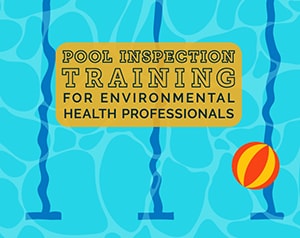Pool Inspection Training for Environmental Health Professionals
Take the Pool Inspection Training for Environmental Health Professionals for healthier and safer pools through stronger inspection skills.
The training provides a basic understanding of an aquatic facility inspection. Based on CDC’s 2016 Model Aquatic Health Code (MAHC), the training addresses aquatic facility systems and walks through a pool inspection using the MAHC inspection form.
Get Started Today
- Visit the training page on the National Environmental Health Association (NEHA) websiteexternal icon and create a free account (or log in if you already have one).
- Enroll in the training.

What Are the Benefits of This Training?
The training has several benefits.
- The training can help you improve pool inspections in your community by better understanding and applying the MAHC and the MAHC inspection form.
- It’s free and flexible. You can take the courses you want, when you want, in this online training.
- You can obtain CEUs (optional) from NEHA upon completing the lessons and final evaluation.
What Topics Are Addressed?
The training includes a guided walk-through of a pool inspection using the MAHC inspection form. It also addresses the various elements and systems of aquatic facilities.
The nine lessons of the training can be taken in any order, but taking them in order follows the inspection form and can enhance learning:
- Introduction to the MAHC
- Recirculation Systems
- Filtration Systems
- Water Disinfection
- Pool/Spa Area
- Water Chemicals
- Equipment Room
- Hygiene Facilities
- Records Room and General
How Long Does It Take?
For pilot testers, the average time to finish a lesson ranged from 30 minutes to 1 hour. Pilot testers completed all nine modules in about 6-8 hours.
Did You Know?
- Drowning is a leading cause of unintentional injury-related death for children ages 1–14 years. Non-fatal drowning can cause brain damage resulting in learning disabilities or even permanent loss of basic functioning.
- Injuries linked to pool chemicals account for 3,000–5,000 emergency department visits each year. Almost half of those injured are under 18 years of age.
- Nearly 500 disease outbreaks linked to pools, hot tubs, and water playgrounds occurred from 2000 to 2014.
- Cryptosporidium is a leading cause of recreational water–associated outbreaks in the United States and can cause diarrhea (for up to 3 weeks).
- Recent studies found that routine inspections resulted in immediate closure of 11.8% (1 out of 8) of public pools and 15.1% (1 out of 7) of public hot tubs because of health hazards.
Register Today
Visit the training pageexternal icon to create an account and register.
Want More?
The MAHC is CDC’s free model code to help state and local programs that regulate public pools, hot tubs, waterparks and other aquatic facilities to reduce the risk of drowning, pool chemical injuries, and outbreaks. Explore more resources below.